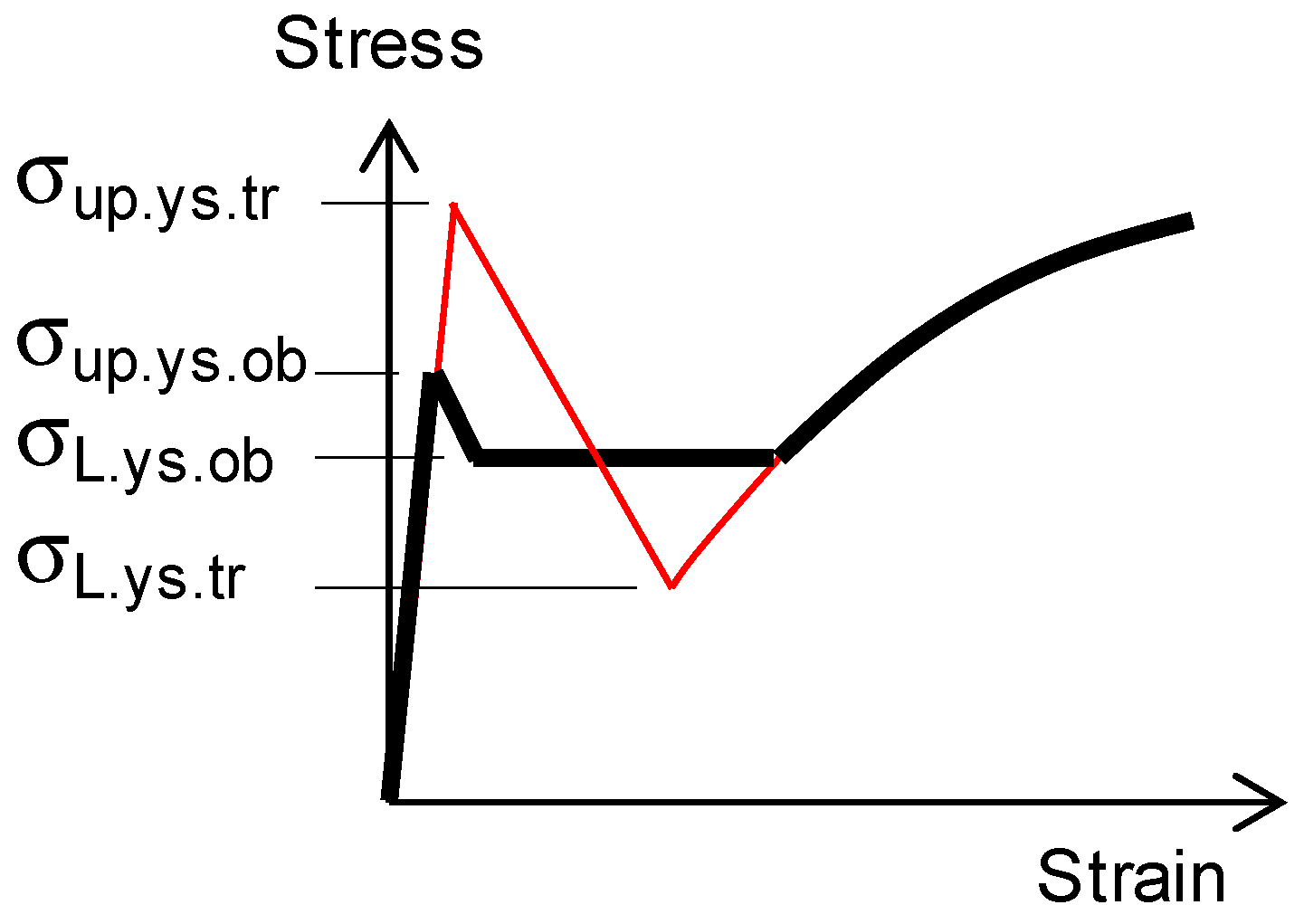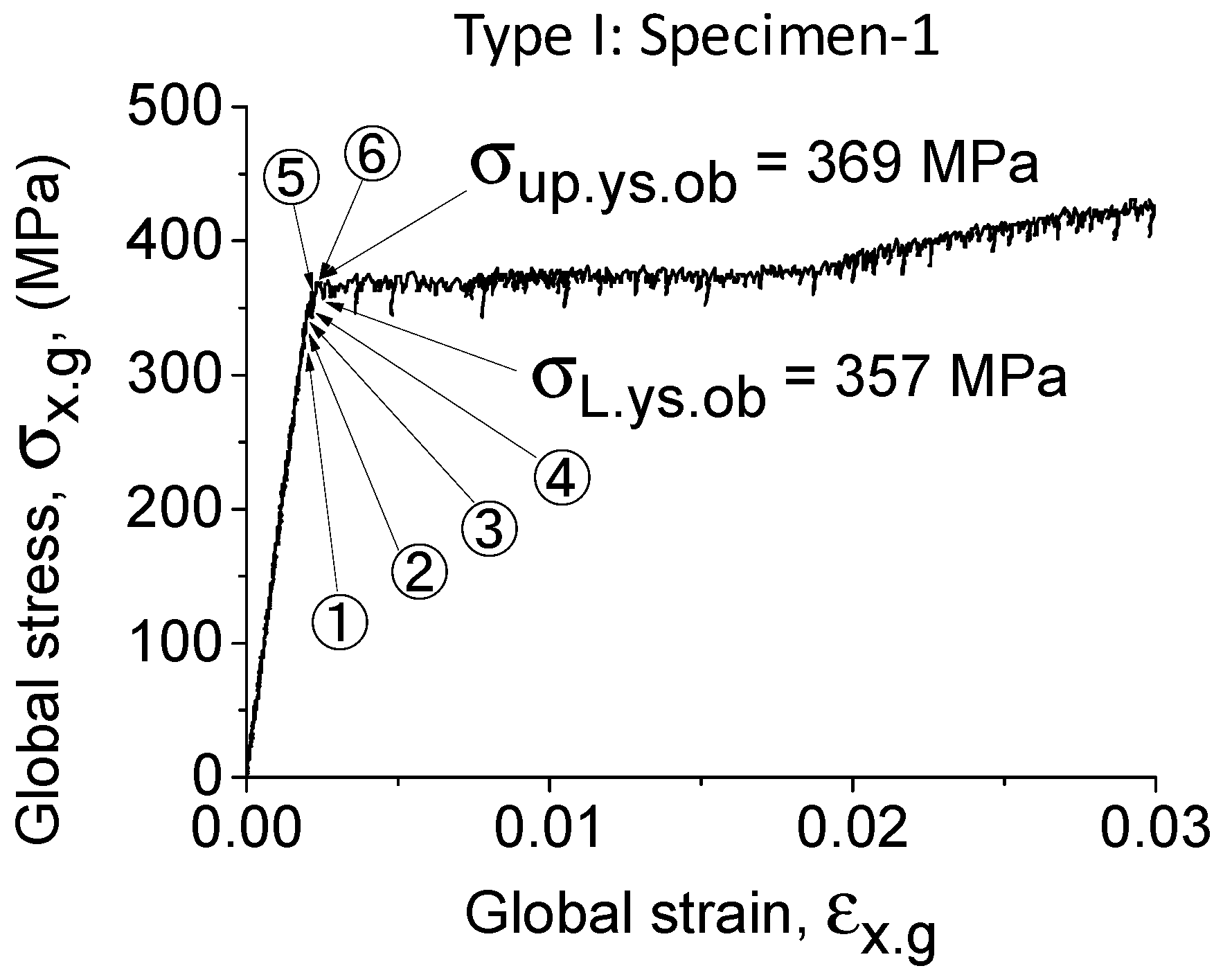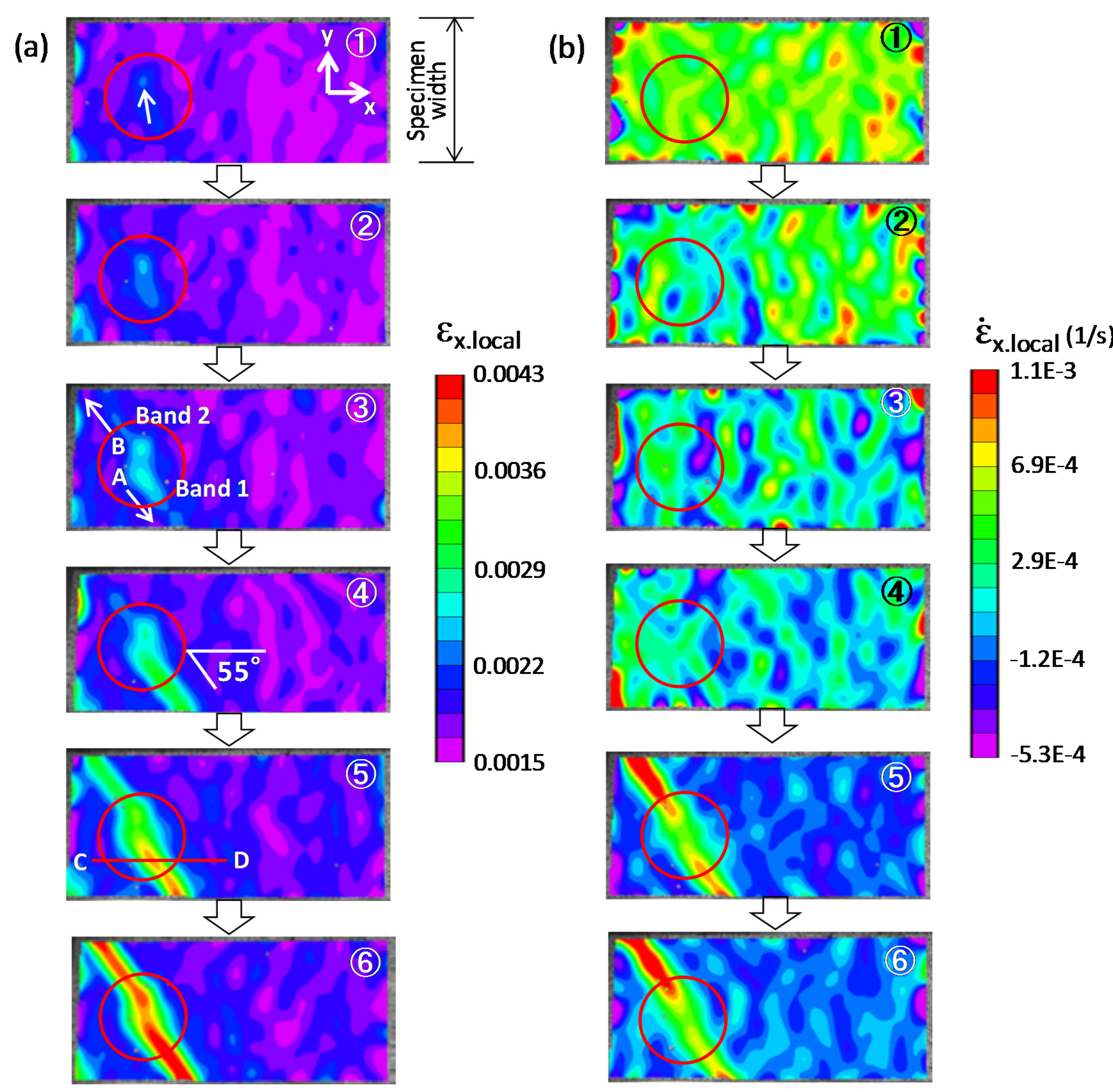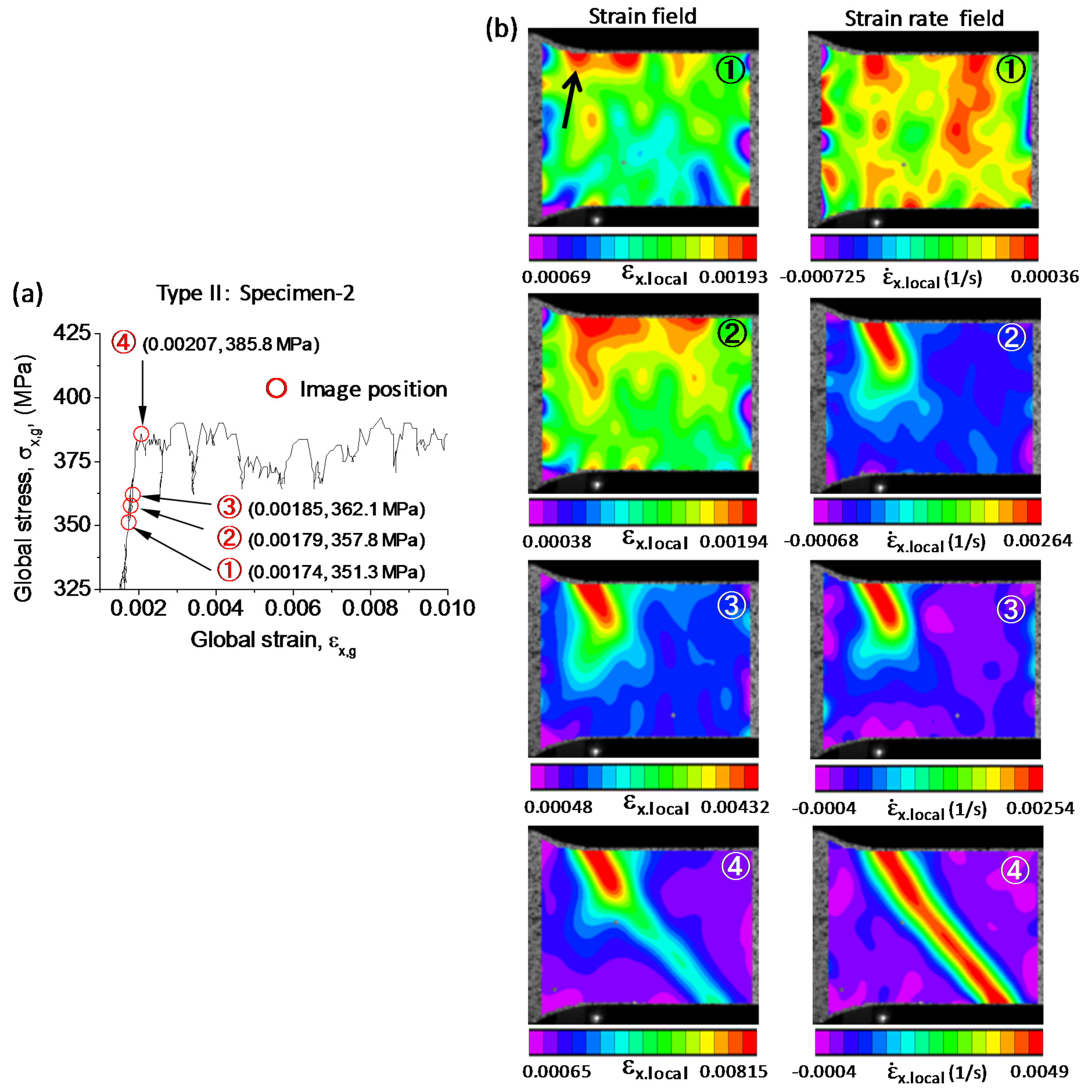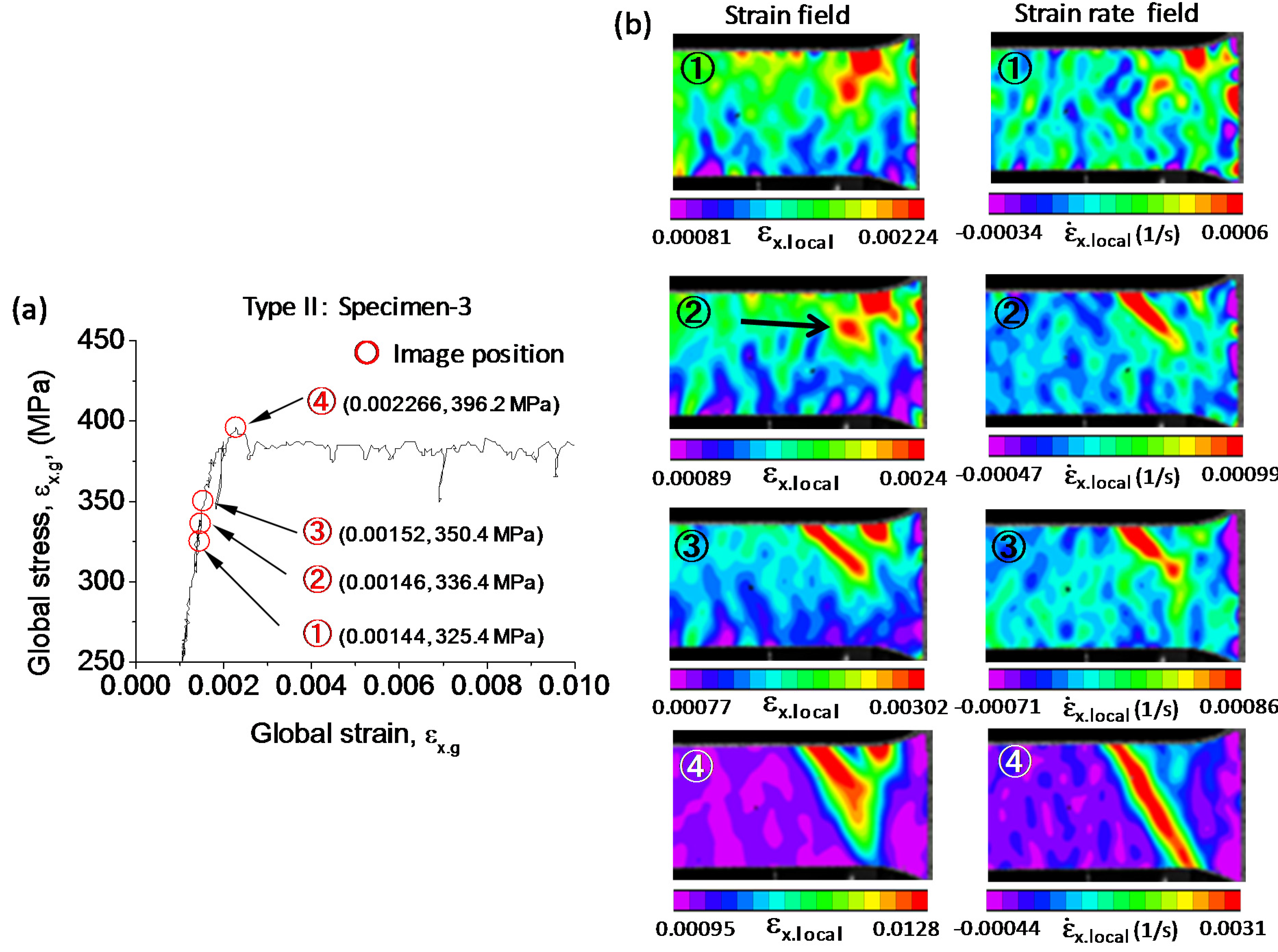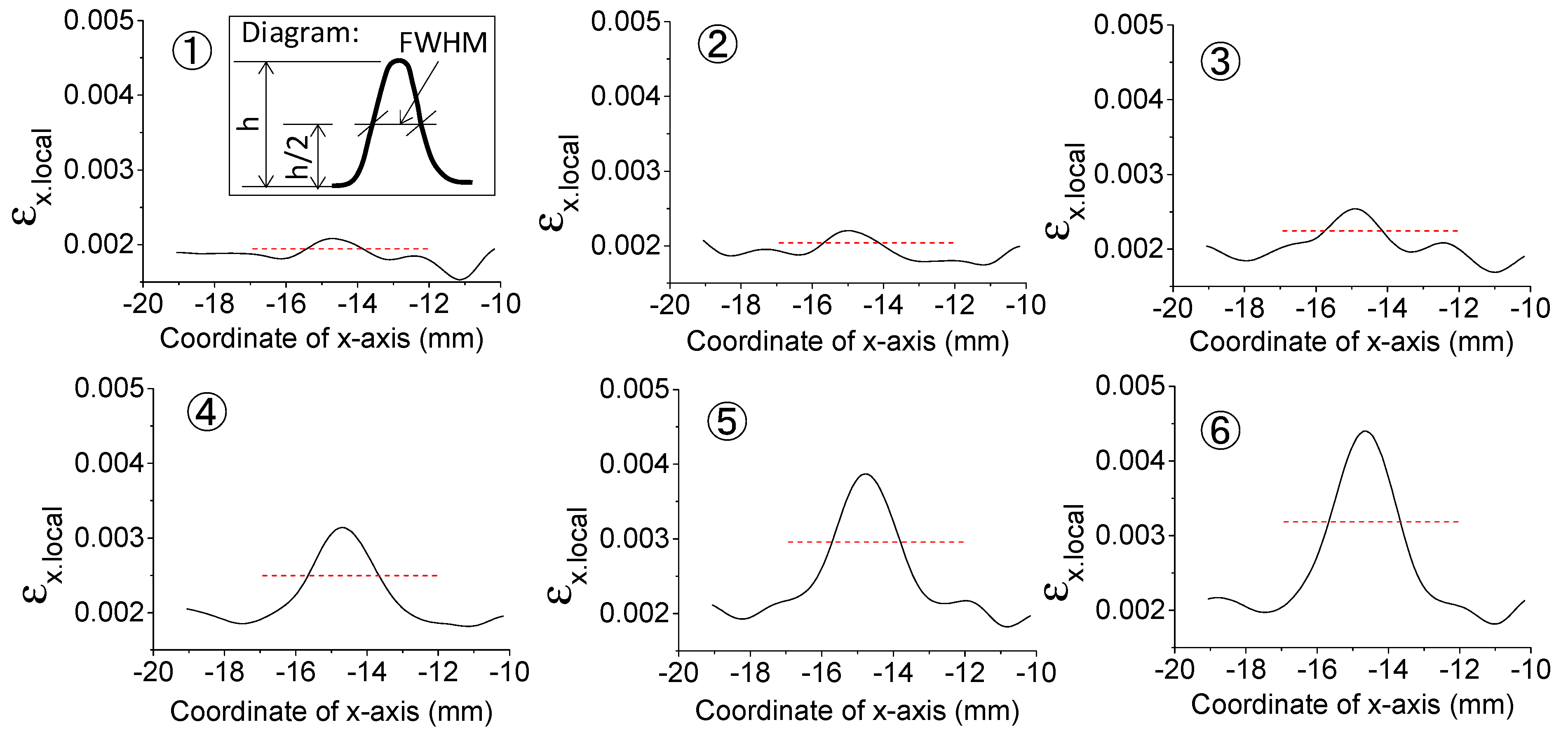3. Results and Discussion
Three tension tests on Type I specimen were performed. The observed area partially covered the gauge length (see
Figure 2). Because the initiation site of Lüders band was beyond the observed area, two tests failed to capture the initiation of Lüders band. Only one test succeeded in capturing the band initiation. Its experimental global stress-strain curve is given in
Figure 4. We defined the first peak point as the macroscopic upper yield point in this study.
Images ① to ⑥ shown in
Figure 4 were selected.
Figure 5a shows the
evolution from image ① to image ⑥, corresponding to the applied stress levels of 318 MPa (0.86
), 332 MPa (0.90
), 345 MPa (0.93
), 351 MPa (0.95
), 364 MPa (0.99
), and 369 MPa (
), respectively (see
Figure 4). The DIC parameter used is a subset size of 9 pixels × 9 pixels (248 μm × 248 μm) and step 5 pixels (138 μm). A region is enclosed by a red circle in
Figure 5a. Strain concentration has occurred at a stress level of 0.86
(image ①), and a small core (shown by an arrow) is visible. At 0.90
(image ②), the core inclines and changes to an elliptical shape. This shows a trace of plastic propagation. In image ③, two cores (marked A and B) are visible. Core A propagates along the arrow toward the lower right side, forming Band 1. Core B goes in the opposite direction to form Band 2. At 0.95
(image ④), Band 1 was completely formed. The band has an angle of 55° with respect to the tension direction. Core B continues to propagate and completely crosses the specimen width at 0.99
(image ⑤). When the applied stress reaches the
, the strain within the Lüders band, i.e., the Lüders strain, reaches its maximum (image ⑥). The Lüders band forms in a very short time. For example, the formation process of Band 1 from image ② to image ④ took only 8 s.
The strain rate fields corresponding to each image in
Figure 5a are given in
Figure 5b. Although strain concentration has occurred in
Figure 5a images ①–④, and a Lüders band has even formed in image ④, serious concentration does not appear in the strain rate field (see
Figure 5b, images ①–④). Subsequently, in images ⑤ and ⑥, a strain rate band appears. The strain rate within the band along the specimen width is inhomogeneous. The center has a lower strain rate, and both sides near the end of the specimen have a higher strain rate. As we know, plastic strain concentration first occurs in the center (cores A and B), and then the plastic flow crosses from there to both ends of the specimen. The increasing strain rate distribution within the band shows the propagation process, like a river flowing from a higher place to a lower place. The flow speed increases gradually. The strain rate of bulk material was directly derived from the evolution of global strain with time. Its value within the elastic region is of the order of 10
−5 s
−1, and the maximum strain rate within the Lüders band is of the order of 10
−3 s
−1. This shows that the Lüders band deforms at a very fast speed (100 times the speed in bulk material).
The images ①–⑥ in
Figure 4 were also dealt with the following DIC parameters: (1) subset size 21 pixels × 21 pixels (579 μm × 579 μm) and step 5 pixels (138 μm), and (2) subset size 41 pixels × 41 pixels (1.13 mm × 1.13 mm) and step 5 pixels (138 μm). The corresponding evolution of local strain field is shown in
Figure 6. Compared with
Figure 5, it can be seen that the sensitivity of a large subset size is lower than that of a small subset size (see the region in the red circle). The DIC parameter of subset size 9 pixels × 9 pixels and step 5 is rational.
Two tension tests on Type II specimen were carried out. Their experimental global stress-strain curves are given in
Figure 7a and
Figure 8a, respectively. In
Figure 7a, stress fluctuation on the yield plateau is great. The nominal upper yield stress (point ④) is not the largest on the yield plateau. The
field and
field evolution from image ① to image ④ is shown in
Figure 7b. A Lüders band begins to form at the shoulder of the specimen at the stress level of 0.927
(
Figure 7b—image ②).
In
Figure 8a, the stress-strain curve is similar to that shown in
Figure 1. The
field and
field evolution from image ① to image ④ is shown in
Figure 8b. It can be seen that the formation of a Lüders band takes place at the stress level of 0.849
(
Figure 8b—image ②). The initiation site is indicated by the arrow at image ②. The observation (
Figure 5,
Figure 7 and
Figure 8) shows that, at the upper yield point, the Lüders band has grown large enough, passing through the specimen width. In
Figure 5b, the strain rate field is not sensitive to identify the band. However, in
Figure 7b and
Figure 8b, the strain rate field is more sensitive than the strain field in identifying a band. The reason for it is unclear. It is better to identify a band using both strain and strain rate fields.
The scatter among the three experimental stress-strain curves, especially in the region of Lüders yield plateau, is great (see
Figure 4,
Figure 7a and
Figure 8a). The yield tooth is visible only in
Figure 8a. Yuzbekova et al. [
15] suggested that the stress serration on the yield plateau is related to the nucleation and propagation of a deformation band. If the Lüders band is developed progressively instead of being formed abruptly, the yield tooth will not show up. The steel SM490 is a commercial steel produced by hot-rolling. It is composed of multiple phases (ferrite and pearlite). The ferrite grain size is not uniform, and the pearlite prefers to distribute along the rolling direction. Moreover, precipitates and inclusions are present. The role of the strong heterogeneity in the microstructure on the stress serration should be investigated in the future.
Strain concentration is related to the formation of a Lüders band. Since the initiation of a Lüders band is similar in
Figure 5,
Figure 7 and
Figure 8, we only focus on
Figure 5 in the following discussion. To quantitatively analyze the strain concentration, we plotted a line parallel to the x-axis (CD line) passing through a strain concentration core in the strain field of
Figure 5a—⑤ and extracted the
along this line. The solid line in
Figure 9 represents its
distribution. Numbers ①–⑥ in
Figure 9 correspond, respectively, to the images ①–⑥ in
Figure 5. A peak appears around position x = −14.6 mm, and the peak value increases, as applied stress increases. The dashed horizontal line shows a strain level of 50% of the peak value.
Applied force simultaneously makes the bulk material and local regions produce global strain (
) and local strain (
), respectively. We define a factor, the ratio of the maximum local strain to global strain,
, to evaluate the extent of the strain concentration, where
is the maximum local strain (peak value in
Figure 9). The evolution of
as a function of normalized applied stress (
) is shown in
Figure 10a.
The critical strain (
) is calculated using
(Young’s modulus E = 210 GPa), beyond which the bulk material enters the plastic region. For the steel used, the
is equal to 0.00176, which is used to determine the boundary between elastic and plastic regions.
Figure 10a shows that the global applied stress level of 0.70
is an elastic-to-plastic threshold value, below which both the bulk material and the local region completely and elastically deform and above which some plastic local regions gradually appear. Within the applied stress range of 0.3–0.9
,
slightly decreases with applied stress, i.e., the extent of the strain concentration slightly decreases. The solid black circle in
Figure 10a is a turning point, and when applied stress exceeds that point,
significantly increases in a short period of time. In-situ observation in
Figure 5 shows that only strain concentration occurs before the stress level of 0.90
. At 0.90
, a Lüders band begins to form, which is followed by rapid propagation. The suddenly increased local strain in
Figure 10a is attributed to the formation and propagation of the Lüders band.
Strain concentration is directly related to stress concentration. We define the stress concentration factor,
, by
(where
is the maximum local stress and
the global stress) and convert
into
.
Figure 10b shows the evolution of
against normalized applied stress. The bulk material is in an elastic state below
, while the stress concentration region is in an elastic state only below 0.70
. In the elastic region, stress (
) and strain (
) have a linear relation, as
. We assume that the stress concentration region has the same Young’s modulus as the bulk material. Therefore,
is equal to
in the range of 0–0.70
. In the plastic region, the relationship between
and
is expressed by
(
k and
n are constants and
n is smaller than one) [
16], and, thus,
is not equal to
.
Figure 4 shows that the strain-hardening capacity of the steel used is weak. The local stress in the plastic stress concentration region is obtained by means of the basic stress-strain curve introduced in the Materials and Methods section.
Figure 10b indicates that the
decreases with the applied stress.
The Lüders band nucleates at the stress concentration site. In the following, we will investigate the correlation of the Lüders band width with the size of the stress concentration region. As shown in
Figure 9, there is no distinct boundary between the concentration region and its adjacent region. Therefore, it is difficult to determine the size of the stress concentration region. It is convenient to use full width at half maximum (FWHM) as a measure of size, which is schematically shown in
Figure 9—①. The size of the stress concentration region (FWHM) against normalized applied stress is given in
Figure 10c. The FWHM varies within 1.33–2.04 mm. Around the
, the FWHM ranges from 1.92 to 2.04 mm. Band 1 formed completely at 0.95
, and the band front has a clear boundary with the matrix (see
Figure 5a—④). We plot a horizontal line, which intersects with the two band fronts, and measure the distance between the two intersection points to give the initial band width. The measured band width is 2.06 mm, which agrees with the FWHM at 0.95
. This indicates that the initial Lüders band width is dependent on the size of the stress concentration region. Previous studies showed that the band width generally ranges from 1 to 15 mm [
17].
We briefly summarize previous studies on Lüders band formation as follows.
Band nucleation criterion [
5,
7]. True upper yield stress (
) is a critical value. When stress reaches it, a band starts to nucleate. The
is not the nominal upper yield stress (
) obtained from the experimental nominal stress-strain curve, and it is difficult to be measured directly by experiment.
is greater than
.
Band nucleation site [
5,
8,
13]. A band nucleates at the stress concentration site. The initial band is generally at the shoulder of the specimen where great stress concentration occurs.
Time point of band nucleation [
6,
8,
9]. A band nucleates at the nominal upper yield stress point or close to it.
The solid black circle in
Figure 10b indicates the starting point of band nucleation, and, thus, the local stress at this point is the
(394 MPa).
Figure 5 shows that macroscopic stress concentration regions provide sites for easy Lüders band formation. The Lüders band nucleates at
(or
). The importance of plastic strain to the nucleation of the Lüders band was recognized in the 1950s [
18,
19]. Vreeland et al. [
18] observed a pre-yield phenomenon prior to the onset of yielding and found the plastic micro-strain to be of the order of 30 με. The plastic strain on a macroscale is regarded to be a prerequisite of Lüders band generation [
19]. The plastic strain at the onset of band nucleation in this study was 365 με, which is much greater than Vreeland’s data. Vreeland likely underestimated the real plastic strain because of the imprecision measurement technique at that time. At the nominal upper yield stress point, the yield band on a well-polished surface is wide enough to be visible even with the naked eye. If the measurement has enough precision, one will find that a yield band was formed prior to the nominal upper yield stress point. Our observation shows that a band nucleates ahead of the nominal upper yield stress point.
